Supermicro's Twin: Two nodes and 16 cores in 1U
by Johan De Gelas on May 28, 2007 12:01 AM EST- Posted in
- IT Computing
Supermicro 6015T-T/6015T-INF Server
Two models exist : the 6015T-INF and the 6015T-T. The only difference is that the former has an additional InfiniBand connector. Supermicro sent us the 6015T-INF. The Superserver 6015T-INF consists of two Supermicro X7DBT-INF dual processor server boards. Each board is based on Intel's 5000P chipset and support two Intel 53xx/51xx/50xx series processors. Let's take a look at the scheme below.

The Intel 5000p chipset has two I/O units, one with two x8 PCIe lanes and a second one with an x8 + x4 PCIe lane configuration. The first PCIe x8 connection of the first I/O unit is used to attach the 20 Gbit/s InfiniBand connection to the Northbridge (MCH). PCIe x8 offers 2 GB/s full duplex, which roughly matches the peak data bandwidth of the InfiniBand connection. InfiniBand is a point-to-point bidirectional serial interconnect, but that probably doesn't say much. To simplify we could describe it as a technology similar to PCI Express, but one that can also be used externally as a network technology like Ethernet - with the difference that this switched networking technology:
Latency sensitive cluster applications that exchange a lot of (synchronizing) data between the nodes are a prime example of where one should use InfiniBand. A good example is Fluent, a Computational Fluid Dynamics (CFD) package. This article, written by Gilad Shainer, a senior technical marketing manager at Mellanox, shows how using low latency InfiniBand offers much better scaling over multiple nodes than Gigabit Ethernet.
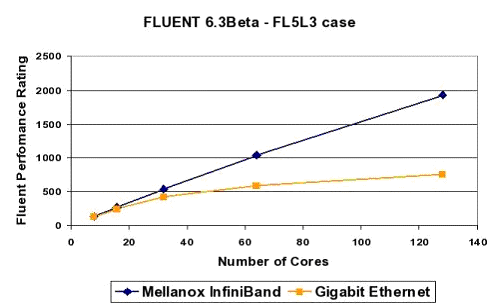
As you can see, with more than 32 cores (or 16 dual core Woodcrest CPUs), Gigabit Ethernet severely limits the performance scaling.
The second PCIe x8 is used as a PCIe slot. PCI-X is not an option due to the limited space available on each X7DB motherboard. So that is one of the limitations of the Twin: there is only one PCIe expansion slot available, which can contain a 2U height card. The PCIe x8 of the second I/O port offers Intel I/O Acceleration Technology (IOAT) to the dual Gigabit Controller. TCP/IP processing is only a small part of the CPU load that is a result of intensive networking activity. Especially with small data blocks, handling the interrupts and signals consumes many more cycles than pure TCP/IP processing.
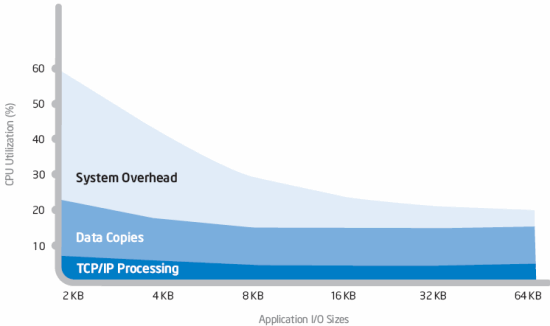
The X7DBT has eight 240-pin DIMM sockets that can support up to 32 GB of ECC FBD (Fully Buffered DIMM) DDR2-667/533 SDRAM and support memory spares.
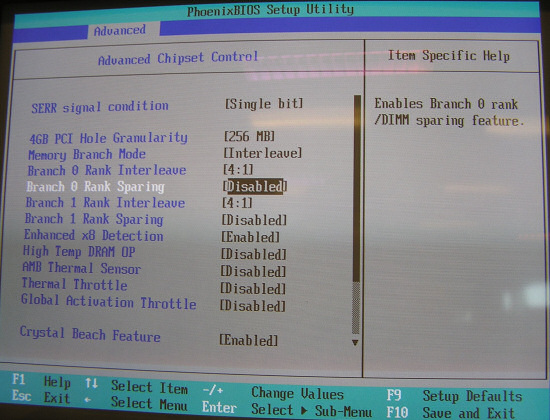
All memory modules used to populate the system should be the same size, type and speed.
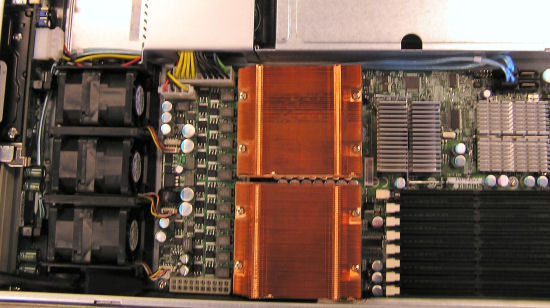
Each board has four SATA connectors, but only two of them are connected to the storage backplane. That means that in reality, you are limited to two SATA disks per node. This is not a real limitation as this server is not intended to be a fileserver or database server. For a front end or HPC cluster node, two SATA disks in RAID-1 should be sufficient.
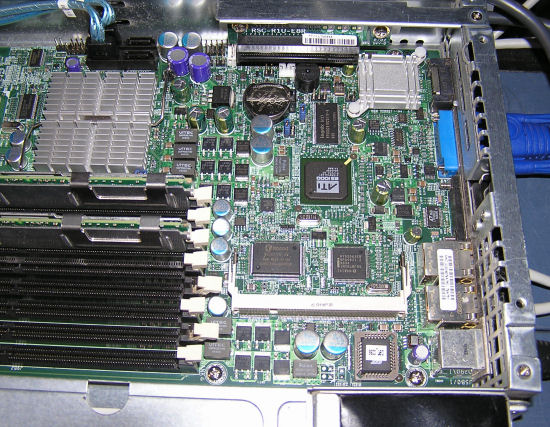
As you can see, expansion is limited to one half height PCIe card. A result of fitting two nodes in a 1U server.
Two models exist : the 6015T-INF and the 6015T-T. The only difference is that the former has an additional InfiniBand connector. Supermicro sent us the 6015T-INF. The Superserver 6015T-INF consists of two Supermicro X7DBT-INF dual processor server boards. Each board is based on Intel's 5000P chipset and support two Intel 53xx/51xx/50xx series processors. Let's take a look at the scheme below.

The Intel 5000p chipset has two I/O units, one with two x8 PCIe lanes and a second one with an x8 + x4 PCIe lane configuration. The first PCIe x8 connection of the first I/O unit is used to attach the 20 Gbit/s InfiniBand connection to the Northbridge (MCH). PCIe x8 offers 2 GB/s full duplex, which roughly matches the peak data bandwidth of the InfiniBand connection. InfiniBand is a point-to-point bidirectional serial interconnect, but that probably doesn't say much. To simplify we could describe it as a technology similar to PCI Express, but one that can also be used externally as a network technology like Ethernet - with the difference that this switched networking technology:
- offers more than 10 times the bandwidth of Gigabit Ethernet (1500 MB/s vs. 125 MB/s)
- 15 to 40 times lower latency than Gigabit Ethernet (2.25 µs vs. 100 µs)
- at a ten times lower CPU load (5% versus 50%)
Latency sensitive cluster applications that exchange a lot of (synchronizing) data between the nodes are a prime example of where one should use InfiniBand. A good example is Fluent, a Computational Fluid Dynamics (CFD) package. This article, written by Gilad Shainer, a senior technical marketing manager at Mellanox, shows how using low latency InfiniBand offers much better scaling over multiple nodes than Gigabit Ethernet.

As you can see, with more than 32 cores (or 16 dual core Woodcrest CPUs), Gigabit Ethernet severely limits the performance scaling.
The second PCIe x8 is used as a PCIe slot. PCI-X is not an option due to the limited space available on each X7DB motherboard. So that is one of the limitations of the Twin: there is only one PCIe expansion slot available, which can contain a 2U height card. The PCIe x8 of the second I/O port offers Intel I/O Acceleration Technology (IOAT) to the dual Gigabit Controller. TCP/IP processing is only a small part of the CPU load that is a result of intensive networking activity. Especially with small data blocks, handling the interrupts and signals consumes many more cycles than pure TCP/IP processing.

The X7DBT has eight 240-pin DIMM sockets that can support up to 32 GB of ECC FBD (Fully Buffered DIMM) DDR2-667/533 SDRAM and support memory spares.

All memory modules used to populate the system should be the same size, type and speed.

Each board has four SATA connectors, but only two of them are connected to the storage backplane. That means that in reality, you are limited to two SATA disks per node. This is not a real limitation as this server is not intended to be a fileserver or database server. For a front end or HPC cluster node, two SATA disks in RAID-1 should be sufficient.

As you can see, expansion is limited to one half height PCIe card. A result of fitting two nodes in a 1U server.










28 Comments
View All Comments
JohanAnandtech - Monday, May 28, 2007 - link
Those DIMM slots are empty :-)yacoub - Monday, May 28, 2007 - link
ohhh hahah thought they were filled with black DIMMs :Dyacoub - Monday, May 28, 2007 - link
Also on page 8:You should remove that first comma. It was throwing me off because the way it reads it sounds like the 2U servers save about 130W but then you get to the end of the sentence and realize you mean "in comparison with 2U servers, we save about 130W or about 30% thanks to Twin 1U". You could also say "Compared with 2U servers, we save..." to make the sentence even more clear.
Thanks for an awesome article, btw. It's nice to see these server articles from time to time, especially when they cover a product that appears to offer a solid TCO and strong comparative with the competition from big names like Dell.
JohanAnandtech - Monday, May 28, 2007 - link
Fixed! Good pointgouyou - Monday, May 28, 2007 - link
The part about infiniband's performance much better as you increase the number of core is really misleading.The graph is mixing core and nodes, so you cannot tell anything. We are in an era where a server has 8 cores: the scaling is completely different as it will depend less on the network. BTW, is the graph made for single core servers ? dual cores ?
MrSpadge - Monday, May 28, 2007 - link
Gouyou, there's a link called "this article" in the part on InfiniBand which answers your question. In the original article you can read that they used dual 3 GHz Woodcrests.What's interesting is that the difference between InfiniBand and GigE is actually more pronounced for the dual core Woodcrests compared with single core 3.4 GHz P4s (at 16 nodes). The explanation given is that the faster dual core CPUs need more communication to sustain performance. So it seems like their algorithm uses no locality optimizations to exploit the much faster communication within a node.
@BitJunkie: I second your comment, very nice article!
MrS
BitJunkie - Monday, May 28, 2007 - link
Nice article, I'm most impressed by the breadth and the detail you drilled in to - also the clarity with which you presented your thinking / results. It's always good to be stretched and great example of how to approach things in structured logical way.Don't mind the "it's an enthusiast site" comments. Some people will be stepping outside their comfort zone with this and won't thank you for it ;)
JohanAnandtech - Monday, May 28, 2007 - link
Thanks, very encouraging comment.And I guess it doesn't hurt the "enthusiast" is reminded that "pcs" can also be fascinating in another role than "Hardcore gaming machine" :-). Many of my students need the same reminder: being an ITer is more than booting Windows and your favorite game. My 2-year old daughter can do that ;-)
yyrkoon - Monday, May 28, 2007 - link
It is however nice to learn about InfiniBand. This is a technology I have been interrested in for a while now, and was under the impression was not going to be implemented until PCIe v2.0 (maybe I missed something here).I would still rather see this technology in the desktop class PC, and if this is yet another enterprise driven technology, then people such as myself, who were hoping to use it for decent home networking(remote storage) are once again, left out in the cold.
yyrkoon - Monday, May 28, 2007 - link
And I am sure every gamer out there knows what iSCSI *is* . . .
Even in 'IT' a 16 core 1U rack is a specialty system, and while they may be semi common in the load balancing/failover scenario(or maybe even used extensively in paralell processing, yes, and even more possible uses . . .), they are still not all that common comparred to the 'standard' server. Recently, a person that I know deployed 40k desktops/ 30k servers for a large company, and would'nt you know it, not one had more than 4 cores . . . and I have personally contracted work from TV/Radio stations(and even the odd small ISP), and outside of the odd 'Toaster', most machines in these places barely use 1 core.
I too also find technologies such as 802.3 ad link aggregation, iSCSI, AoE, etc interresting, and sometimes like playing around with things like openMosix, the latest /hottest Linux Distro, but at the end of the day, other than experimentation, these things typically do not entertain me. Most of the above, and many other technologies for me, are just a means to an end, not entertainment.
Maybe it is enjoyable staring at a machine of this type, not being able to use it to its full potential outside of the work place ? Personally I would not know, and honestly I really do not care, but if this is the case, perhaps you need to take notice of your 2 year old daughter, and relax once in a while.
The point here ? The point being: pehaps *this* 'gamer' you speak of knows a good bit more about 'IT' than you give him credit for, and maybe even makes a fair amount of cash at the end of the day while doing so. Or maybe I am a *real* hardware enthusiast, who would rather be reading about technology, instead of reading yet another 'product review'. Especially since any person worth their paygrade in IT should already know how this system (or anything like) is going to perform beforehand.